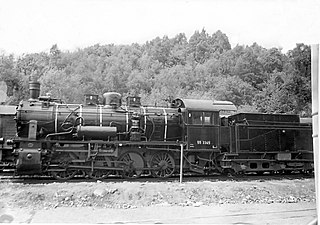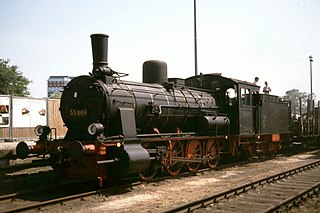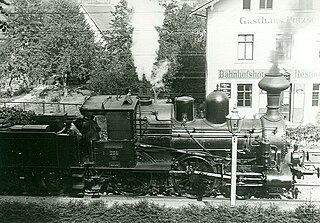The Bavarian Pt 2/4 N was a steam locomotive with the Royal Bavarian State Railways. It was developed in parallel with the Bavarian Pt 2/3 and for the same duties. Instead of a fixed carrying axle it was given a bogie. This change brought no advantage, so the more cost-effective Pt 2/3 was favoured. The two Pt 2/4 N engines were nevertheless taken over by the Reichsbahn, but were retired by 1928.

The goods train locomotives of Class C VI were German steam engines built between 1899 and 1905 for the Royal Bavarian State Railways. It had great similarity to the Prussian G 5.4, but had a higher boiler overpressure and better riding qualities. In all the Bavarian state railways procured 83 engines of this type over that period. More machines with slight modifications were acquired between 1907 and 1909. These 37 engines were given the designation G 3/4 N. The Deutsche Reichsbahn inherited 64 Class C VI and 32 Class G 3/4 N engines. These were given operating numbers 54 1301–1364 and 54 1401–1432. The Class C VII locomotives remained in service until 1931, their Class G 3/4 N sister locomotives until 1935.

The Prussian G 8.1 was a heavier, stronger development of the G 8 and was initially referred to as a 'strengthened standard class'.

The Prussian T 18 was the last class of tank locomotives developed for the Prussian state railways. They were originally intended for services on the island of Rügen as replacements for Class T 12 and T 10 engines. They emerged when a class of locomotive was conceived in 1912 that was to handle express and passenger trains in border areas or in shuttle services on short routes. A tank engine design with symmetrical running gear was envisaged because, unlike a tender locomotive, it could run equally fast forwards and backwards and could be operated on return journeys without having to be turned on a turntable. Its power and top speed were to be the same as those of the P 8. Robert Garbe designed this 4-6-4 (2′C2′) tank locomotive for 100 km/h with a 17-ton axle load and contracted the Vulkan Werke in Stettin to build it. It was given the designation T 18.

The Prussian G 10 was a German goods train, steam locomotive, whose design was based on a combination of the running and valve gear from the Prussian T 16 and the boiler from the Prussian P 8. In developing the G 10, however, the T 16 running gear with side play on the first and fifth axles was modified. The T 16 was also subsequently built with this modified configuration and called the Prussian T 16.1. The G 10 was intended for heavy goods train duties on main lines, but as a result of its low axle load it could be employed more flexibly than its equally powerful cousin, the Prussian G 8.1. The G 10 was occasionally even used in passenger train service.
The Oldenburg T 2 steam locomotives were German 0-4-0 tank engines built between 1896 and 1913 for the Grand Duchy of Oldenburg State Railways. They were designed for use on branch lines. A total of 38 units were produced, based on a Prussian T 2 prototype and differing only in the boiler fittings. Unlike their Prussian cousins, they had no steam dome and the regulator was located in the smokebox. Its permitted top speed of 50 km/h was also higher than the Prussian version.
The Oldenburg G 4.2 steam locomotives were goods train engines built for the Grand Duchy of Oldenburg State Railways between 1895 and 1909 in several series.

The Oldenburg G 7 steam locomotive was a German 0-8-0 locomotive produced for the Grand Duchy of Oldenburg State Railways. It was an eight-coupled engine, intended for heavy goods train duties, and was based on the Prussian G 7. It had a 1,660 mm diameter boiler located 2,820 mm above the top of the rails in the plate frame, and was equipped with a single Walschaerts valve gear as well as a Lentz valve gear. Thirteen were taken over by the Deutsche Reichsbahn, grouped into DRG Class 55.62 and given numbers 55 6201–55 6213.

The Prussian T 16.1 locomotives were built for the Prussian state railways as goods train tank locomotives about the time of the First World War. Six examples were also procured by the Imperial Railways in Alsace-Lorraine.

The Saxon Class III b were German steam locomotives built for the Royal Saxon State Railways in the late 19th century as tender locomotives for express train duties. In 1925, the Deutsche Reichsbahn incorporated the engines into DRG Class 34.77-78.
The Prussian G 5.4 was a German goods train locomotive with a compound engine. Due to its top speed of 65 km/h it was also used on passenger services. The G 5.4, like the G 5.3, differed from the G 5.1 and G 5.2 in having a shorter wheelbase and higher boiler pitch. In addition, the Krauss-Helmholtz bogies enabled its riding qualities to be improved, especially at higher speeds. Between 1901 and 1910 a total of about 760 vehicles of the Class G 5.4 were built for the Prussian state railways. The last 25 locomotives were fitted once again with an Adams axle.

In 1905 the Prussian state railways grouped six-coupled, medium-powered, goods train, tank locomotives into its Class G 3. In addition to standard locomotives, there were also 285 G 3s that were not built to German state railway norms, because they had been built, in most cases, before the foundation of the Prussian state railways.

The Prussian Class P 6s were passenger locomotives operated by the Prussian state railways with a leading axle and three coupled axles.

The Baden VI b was the first German tank locomotive with a 2-6-2 wheel arrangement. It was developed by the firm of Maffei for the Grand Duchy of Baden State Railways in order to provide faster services on the Höllentalbahn. As a result, the first six batches were given a firebox sloping to the rear. One striking feature was also the connecting pipe between the two steam domes.

The Prussian Class G 7.1 engines of the Prussian state railways were German eight-coupled, goods train, steam locomotives.
The Prussian G 8.3 was a 2-8-0, superheated, freight locomotive with three cylinders. It was developed to redress the lack of goods locomotives after the First World War. The inspiration to design a 2-8-0 locomotive based on the 2-10-0 Prussian G 12 came from Württemberg. The first vehicle was delivered in 1918. Compared with the G 12, the G 8.3 had one boiler shell and coupled axle fewer. After it had proved itself, a total of 85 examples of the G 8.3 were placed in service, all of which were taken over by the Reichsbahn, where they were numbered 56 101 to 56 185. No more were built thereafter because the G 8.2, with only two cylinders, was less costly to procure and maintain.
The Prussian G 8.2 class of locomotives actually incorporated two different locomotive types: one was the Prussian/Oldenburg G 8.2, for which the Deutsche Reichsbahn subsequently issued follow-on orders; the other was the G 8.2 of the Lübeck-Büchen Railway.
The Prussian G 5.5's were early German freight locomotives with a compound engine. Unlike the otherwise identical G 5.4 they had a leading Adams axle instead of a Krauss-Helmholtz bogie. The delivery of the G 5.5 in 1910 followed directly on from that of the G 5.4. A total of either 20 or 25 G 5.5 were built.

The Prussian Class T 12 is an early, German, passenger train, tank locomotive built for the Prussian state railways in large numbers. These locomotives were superheated variants of the T 11.

The Prussian G 7.3 was a class of 2-8-0 locomotives of the Prussian state railways. The third class of the G 7 series, they were intended to power heavy goods trains on steep inclines, on which the permissible axle load was not yet that high. This affected for example, the Paderborn–Holzminden and Betzdorf–Siegen routes.











